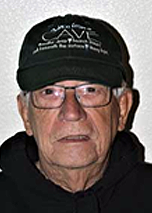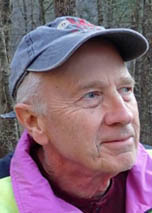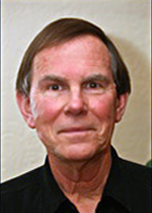Luminaries Home
RICHARD BREISCH Rich started rock climbing his first weekend of his freshman year at Pennsylvania State University. The following September, his younger brother, Alvin, joined him at PSU. In February, when it was too cold to rock climb, they tried caving with the Nittany Grotto. Their first wild cave was Milroy Cave, Pennsylvania's muddiest. After graduation, Rich was commissioned in the U.S. Army. His training included 5 months in Huntsville, Alabama, where each weekend Huntsville Grotto members took him to another vertical cave. Rich assisted with the project that produced the "Into the Depths of Fern" slide show. The rest of Rich's Army service was at White Sands Missile Range in New Mexico, where he continued rock climbing and caving on weekends. The gypsum caves near Carlsbad and limestone caves in the Guadalupe Mountains became his favorites. After leaving the Army, Rich spent the next 4 years as a mathematics graduate student, first at the University of Colorado and later back at PSU. Rich spent most of his college breaks exploring caves - both near and far. Later he moved back to New Mexico and has lived in California since 1976. He led the mapping of Greenhorn Caves, which are tight, difficult caves in quartz diorite rock. He now lives in San Diego. Although devoid of limestone caves, San Diego County has many sea caves, caves in granitic rock, and "mud caves". Rich has explored wild caves throughout the U.S. and in nine foreign countries. He compiled four issues of American Caving Accidents and authored Lost in a Cave, which was published by the NSS in 2012. Download a copy (1:06:39, 548 MB)
RALPH O. EWERS, PhD Ralph Ewers got interested in rocks and minerals on a family trip to the Rocky Mountains. When he returned home, the Cincinnati newspaper had an article on Saturday classes in rocks and minerals for kids. He enrolled immediately and decided by age 10 that he wanted to be a geologist and a museum director. He claims that he has nothing left to live for. On a museum-sponsored trip to Carter Caves State Park in Kentucky he became interested in caves and karst. That led to building a walk-through exhibit cave and, on the side, directing a planetarium at the museum, a bachelor's and master's degree at the University of Cincinnati and a Ph.D. in geology studying karst with Dr. Derek Ford at McMaster University in Canada. Following a stint as a Science Museum Director in Florida he returned to Kentucky to teach geology at the University of Kentucky and Eastern Kentucky University. After serving as supervisor for 34 graduate students who studied karst, he and his wife, the other Dr. Ewers, formed a consulting firm dealing primarily with contaminant issues in karst aquifers. This helped him support those grad students and took Ralph to the Caribbean, Canada, Mexico, South America, and Europe to help deal with the terrible things that humans have released into their limestone groundwater...their drinking water. Ralph claims that he is one of the most fortunate people on the planet, in that he has always been able to earn a living doing what he loves to do... explore caves and karst.
Download a copy (32:15, 176 MB)
FRANK BINNEY Tales of endless passages honey-combing the Mojave Desert mountains near his childhood home inspired Frank Binney from the time he first learned to crawl. At age 5, he followed his dad into an abandoned mine, took a wrong turn and fell into his first pit. Banned from further mine exploration, Frank directed his subterranean curiosity to the sea caves beneath his grandparents' cliffside home in Laguna Beach. He squeezed to the back of every enterable fissure he could find and corralled other young kids for digging projects to remove the sand and cobbles blocking access to the vast chambers that surely lay beyond. Then the big breakthrough - Frank discovered karst! Dragged kicking and screaming to Missouri at age 10 when his dad took a new job, Frank found salvation in Ozark limestone. An NSS member Boy Scout leader introduced him to "real caving" at age 12 and a local science teacher taught him how to survey. Soon he was spending every weekend and holiday underground. By his mid-teens he was president of his high school caving club and making pilgrimages to Central Kentucky and TAG Country. Then the next big breakthrough - Frank discovered Mexican karst! At 17, a volunteer gig showing AMCS geologist John Fish some Ozark caves led to an invitation to camp with "the Texans" at the 1968 NSS Convention. Frank's life changed forever. Before leaving high school he yo-yo'ed Golondrinas and bottomed other significant Mexican vertical caves. He began dividing his caving time between Mexico, Texas, the Ozarks, and Southern California. At 21, he moved to Austin, Texas where he founded the Kirkwood Cavers house and became one of the AMCS "pit hippies". He participated in numerous first descents - including El Sotano del Barro - launched Inside Earth, a short-lived glossy caving magazine sold only to cavers, and accompanied Bill Stone on his first trip to Huautla. Other highlights in Frank's "coming of age as a caver" include a CFF expedition to Costa Rica, and assisting British speleo filmmaker Sid Perou on Castleguard: Challenge Under the Glacier and on the documentary of a 6-month expedition searching for the World's Deepest Cave in Papua New Guinea. Download a copy (42:10, 680 MB)
PHIL LUCAS Phil Lucas’ underground exploits are legion and include extensive poking, prodding, digging, excavating, exploring, and surveying in the Water Sinks area. This fascinating karst region is located in Highland County, Virginia; positioned at the north end of Burnsville Cove; the site of the Lucas retirement house; and the place where Phil first met his high school sweetheart, Charlotte. The Lucas-led initiative at Water Sinks resulted in many miles of fabulous cave being discovered, explored, and surveyed. In addition, a nature trail was developed in order to educate school groups and other members of the public about the value of caves as a resource. Deeming it appropriate to memorialize the vast amount of work done in the area, Phil Lucas published Caves and Karst of the Water Sinks Area, and he received a Certificate of Merit from the NSS for the result. Phil is an accomplished and award-winning photographer and cartographer. Always curious about subterranean water flow routes, Lucas has performed dye traces—some of which have charted underground streams flowing beneath surface rivers. Phil’s associated interest in air currents spawned a unique method for measuring air flow between cave entrances. Working with collaborators Nevin Davis and Frank Marks, this procedure was published under the title “A Method for Detecting Cave Connections by Inducted Air Flow.” Phil has also had a long-term interest in the Culverson Creek area. Believing that the earlier surveys could be improved, Lucas—along with Bill Royster and others—spent a decade pushing and mapping in the Culverson Creek complex. When these cavers were done, Phil—in company with Bill Balfour and George Dasher—authored The Caves and Karst of the Culverson Creek Basin. This tome is populated with historic photographs, detailed maps, and a boatload of adventure.
BILL JONES After graduation from high school in Fairmont, West Virginia, Bill Jones and a buddy set out on a much-anticipated road trip. The boys enjoyed a stop at Seneca Rocks and noticed a place on their map with the curious name Sinks of Gandy. They decided to check it out. Bill was mesmerized by a hillside that simply swallowed up a big surface stream. Two weeks later the guys were back with carbide lamp and helmet, and Jones began his career as a cave explorer. Perhaps spawned by previous sightseeing at the Sinks of Gandy, Bill Jones became pretty jazzed about underground water very early on. The routes that water apparently pursued on its mysterious journeys seemed curious, unknown, and worthy of investigation. And, Jones was just the man for the job. Work at the West Virginia Geological Survey was followed by employment at the United States Geological Survey. Along the way, Bill did many water-tracing experiments in both Greenbrier and Monroe counties. In 1984, Bill Jones edited a special issue of the NSS Bulletin (now the Journal of Caves and Karst Studies) devoted to water tracing. This followed his prior publication of numerous scientific papers, plus the 1973 monograph entitled Hydrology of Limestone Karst in Greenbrier County, West Virginia. Although he sometimes thinks of himself as more of a hydrologist than a speleologist, Bill is no stranger to caves and to hard caving. He discovered Sinks of the Run Cave, mapped Taylor Falls Cave, worked in Culverson Creek Cave and in Friars Hole Cave, and helped Bill Douty survey Bransford Cave. Along the way, Jones was a key player in three separate rescues in the wet, the vertical, and the dangerous place named Cass Cave.
While visiting relatives in Kentucky as a 13-year-old youngster, Bill Balfour—with his dad and uncle—drove over to Mammoth Cave. Balfour was particularly fascinated by the Rotunda and begged the adults for another commercial tour. Bill was entranced and soon bought every book about caves that he could find. During Spring Break in 1968, Bill Balfour and a friend did a productive trip to West Virginia. They entered the Lipps entrance to Organ Cave and climbed at Seneca Rocks. With topographic maps and a copy of William Davies’ classic Caverns of West Virginia in hand, the team was also able to locate Cass, Culverson Creek, Schoolhouse, and other great caves. West Virginia now firmly in his heart, Balfour began his long association with the West Virginia Association for Cave Studies (WVACS) and with the West Virginia Speleological Survey (WVASS). Bill has co-authored a pair of WVASS bulletins, computerized the West Virginia cave database, and has served as President, Chairman of the Board, and a Director of WVACS. As an aspiring architect at the initial explosion of his caving career, Bill could draw. As such, he became extremely interested in surveying and was only too glad to keep book, do the in-cave sketching, and draft the resulting map. His output is prolific — several hundred maps of caves both large and small. Recalling the most productive part of his caving career, Bill Balfour estimates that perhaps 90-percent of his trips were involved with surveying. One of Bill’s favorite locations is the Culverson Creek Cave System. The historic entrance to this cavern is located near the tiny community of Unus, West Virginia. Balfour jokes that he became so enchanted with Unus that he bought the town. In fact, Bill does own a beautiful farm in the area and, each year, many cavers park on his property while visiting Culverson Creek. A short walk from his house is what is now known as the Balfour-Hinkle-Unus Entrance to the cave, and Bill owns that too. And, across the way is the Wild Cat Entrance to Culverson Creek. Return to Luminaries Home |
6001 Pulaski Pike
Huntsville, AL 35810-1122 USA
(256) 852-1300
nss@caves.org
Contact NSS IT/Web Support






Visit our social media sites, too!
©Copyright National Speleological Society, 1995 - 2023.
NSS & the logo are ®registered trademarks.







